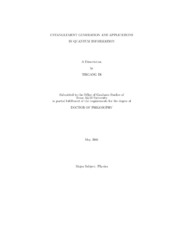| dc.description.abstract | This dissertation consists of three sections. In the first section, we discuss the generation
of arbitrary two-qubit entangled states and present three generation methods.
The first method is based on the interaction of an atom with classical and quantized
cavity fields. The second method is based on the interaction of two coupled two-level
atoms with a laser field. In the last method, we use two spin-1/2 systems which
interact with a tuned radio frequency pulse. Using those methods we have generated
two qubit arbitrary entangled states which is widely used in quantum computing and
quantum information. In the second section, we discuss a possible experimental implementation
of quantum walk which is based on the passage of an atom through a
high-Q cavity. The chirality is determined by the atomic states and the displacement
is characterized by the photon number inside the cavity. Our scheme makes quantum
walk possible in a cavity QED system and the results could be widely used on
quantum computer. In the last section, we investigate the properties of teleporting
an arbitrary superposition of entangled Dicke states of any number of atoms (qubits)
between two distant cavities. We also studied teleporting continuous variables of an
optical field. Teleportation of Dicke states relies on adiabatic passage using multiatom
dark states in each cavity and a conditional detection of photons leaking out of both cavities. In the continuous variables teleportation scheme we first reformulate
the protocol of quantum teleportation of arbitrary input optical field states in
the density matrix form, and established the relation between the P-function of the
input and output states. We then present a condition involving squeeze parameter
and detection efficiency under which the P-function of the output state becomes the
Q function of the input state such that any nonclassical features in the input state
will be eliminated in the teleported state. Based on the research in this section we
have made it possible of arbitrary atomic Dicke states teleportation from one cavity
to another, and this teleortation will play an essential role in quantum communication.
Since quantum properties is so important in quantum communication, the
condition we give in this section to distinguish classical and quantum teleportation is
also important. | en |


